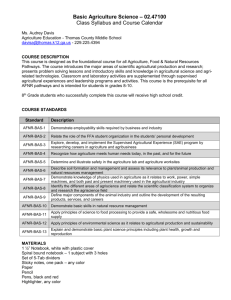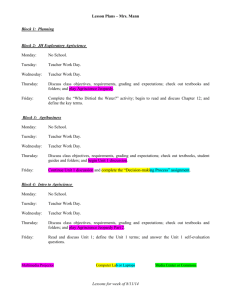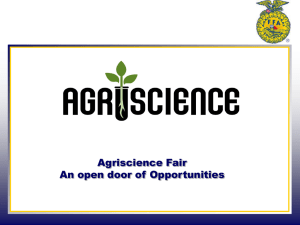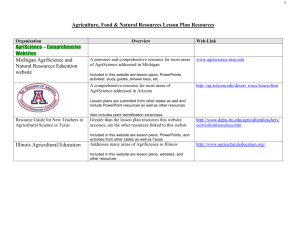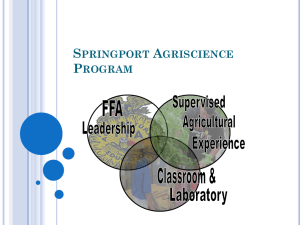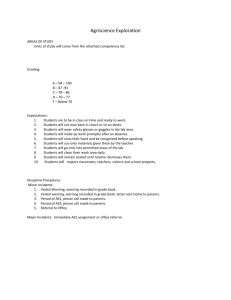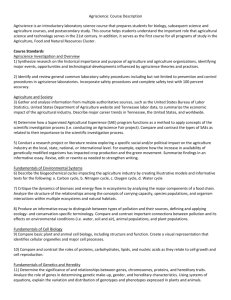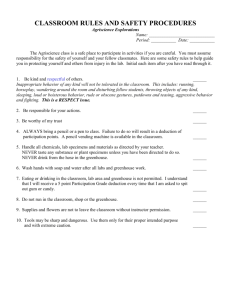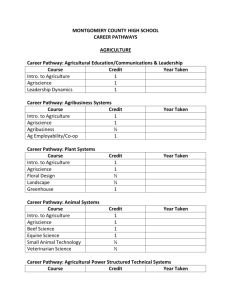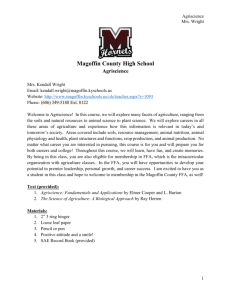Agriscience Fair - California Agricultural Teachers` Association
advertisement
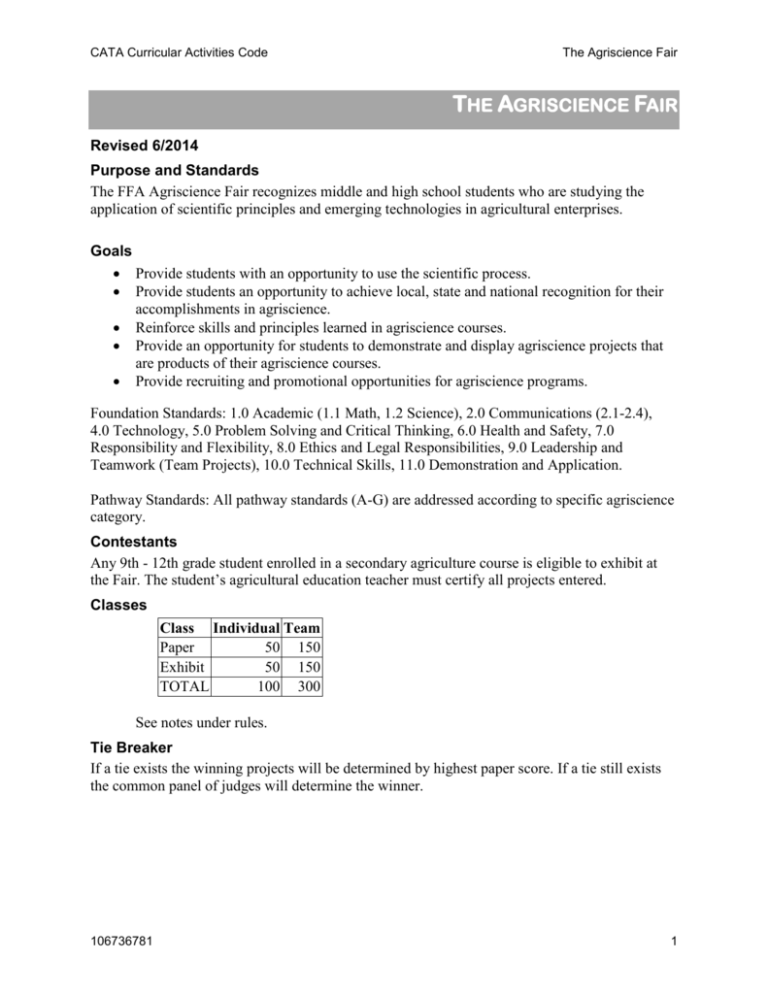
CATA Curricular Activities Code The Agriscience Fair THE AGRISCIENCE FAIR Revised 6/2014 Purpose and Standards The FFA Agriscience Fair recognizes middle and high school students who are studying the application of scientific principles and emerging technologies in agricultural enterprises. Goals Provide students with an opportunity to use the scientific process. Provide students an opportunity to achieve local, state and national recognition for their accomplishments in agriscience. Reinforce skills and principles learned in agriscience courses. Provide an opportunity for students to demonstrate and display agriscience projects that are products of their agriscience courses. Provide recruiting and promotional opportunities for agriscience programs. Foundation Standards: 1.0 Academic (1.1 Math, 1.2 Science), 2.0 Communications (2.1-2.4), 4.0 Technology, 5.0 Problem Solving and Critical Thinking, 6.0 Health and Safety, 7.0 Responsibility and Flexibility, 8.0 Ethics and Legal Responsibilities, 9.0 Leadership and Teamwork (Team Projects), 10.0 Technical Skills, 11.0 Demonstration and Application. Pathway Standards: All pathway standards (A-G) are addressed according to specific agriscience category. Contestants Any 9th - 12th grade student enrolled in a secondary agriculture course is eligible to exhibit at the Fair. The student’s agricultural education teacher must certify all projects entered. Classes Class Individual Team Paper 50 150 Exhibit 50 150 TOTAL 100 300 See notes under rules. Tie Breaker If a tie exists the winning projects will be determined by highest paper score. If a tie still exists the common panel of judges will determine the winner. 106736781 1 CATA Curricular Activities Code The Agriscience Fair Agriscience Fair Rules I. Judging Divisions A. Division I – Individual member in grade 9. B. Division II – Individual member in grades 10, 11, or 12. C. Division III – Team of two members in grade 9. D. Division IV – Team of two members in grades 10, 11, or 12. II. Judging Categories There are six different categories. They are: Food Products and Processing Systems (FPP) The study of product development, quality assurance, food safety, production, sales and service, regulation and compliance and food service within the food science industry. Examples: Effects of packaging techniques on food spoilage rates Resistance of organic fruits to common diseases Determining chemical energy stored in foods Control of molds on bakery products Environmental Services/Natural Resource Systems (ENR) The study of systems, instruments and technology used in waste management; the study of the management of soil, water, wildlife, forests and air as natural resources and their influence on the environment. Examples: Effect of agricultural chemicals on water quality Effects of cropping practices on wildlife populations Compare water movements through different soil types Animal Systems (AS) The study of animal systems, including life processes, health, nutrition, genetics, management and processing, through the study of small animals, aquaculture, livestock, dairy, horses and/or poultry. Examples: Compare nutrient levels on animal growth Research new disease control mechanisms Effects of estrous synchronization on ovulation Compare effects of thawing temperatures on livestock semen Effects of growth hormone on meat/milk production Plant Systems (PS) The study of plant life cycles, classifications, functions, structures, reproduction, media and nutrients, as well as growth and cultural practices, through the study of crops, turf grass, trees and shrubs and/or ornamental plants. Examples: Determine rates of transpiration in plants Effects of heavy metals such as cadmium on edible plants Compare GMO and conventional seed/plant growth under various conditions 106736781 2 CATA Curricular Activities Code The Agriscience Fair Effects of lunar climate and soil condition on plant growth Compare plant growth of hydroponics and conventional methods Power, Structural and Technical Systems (PST) The study of agricultural equipment, power systems, alternative fuel sources and precision technology, as well as woodworking, metalworking, welding and project planning for agricultural structures. Examples: Develop alternate energy source engines Create minimum energy use structures Compare properties of various alternative insulation products Investigation of light/wind/water energy sources Social Systems (SS) The study of human behavior and the interaction of individuals in and to society, including agricultural education, agribusiness economic, agricultural communication, agricultural leadership and other social science applications in agriculture, food and natural resources. Examples: Investigate perceptions of community members towards alternative agricultural practices Determine the impact of local/state/national safety programs upon accident rates in agricultural/natural resource occupations Comparison of profitability of various agricultural/natural resource practices Investigate the impact of significant historical figures on a local community Determine the economical effects of local/state/national legislation impacting agricultural/natural resources If the judges feel the project doesn’t match the category it will be moved to the correct category. III. There shall be six categories and four divisions at the Agriscience Fair. A. Within each of the four divisions, individual and team projects will be judged separately in each of the six categories. There will be individual and team project winners designated from each of the four divisions within each of the six categories. B. At the State Finals competition, all projects in each division within each category will be placed through third place and the results will be distributed. C. All category winners from Divisions I through IV will be selected on scores from the display board and paper. Each category/division will produce a winner which will represent California at National FFA Competition. Projects selected to represent a Chapter Group will still be judged in the traditional manner to compete for category honors and the chance in the National FFA Competition. D. Chapters will be allowed to enter as many exhibits per category as they choose. E. Individual and team projects that receive first place or represent California at the National Agriscience Fair are indefinitely banned from competing in the same category within that division. 106736781 3 CATA Curricular Activities Code The Agriscience Fair IV. Selection of Overall Division winners. There shall be awarded overall winners for Divisions I through IV. The division winners shall be selected from the six category winners. V. Selection of the State Champion Chapter Group. A. For the selection of the overall top five State Champion Chapter Group, Novice and Advanced schools in the Agriscience Fair, each chapter will select three projects to be considered for the Chapter Group competition. The three projects may be composed of individual or team projects. Novice Chapter groups will consist of projects from Division I and/or III; Advanced Chapter groups will consist of projects from Division II and/or IV. B. Teams will be identified when papers are submitted and any substitutions must be made with the contest coordinator one week prior to competition by 8 a.m. C. Judging and scoring of projects will be modeled after the National FFA Agriscience Fair. The student or students from each project will be in attendance for a ten (10) minute presentation and interviewed on the day of the competition. A common panel of judges will interview the student or students making up each team. Interviews will take place in front of the students’ display board amidst all the projects in the competition. D. Scoring the projects will be based on the ten (10) minute student interview and five (5) minutes for the judges to review the paper and display board. The judges will use the National Agriscience scorecard for judging the projects and score sheets from the judges will be added up from each project to compose the chapter’s overall Chapter Group score. E. The Chapter Group will be placed first through fifth based on overall Chapter Group points and there shall be awarded a team championship at both the Novice and Advanced levels. Exhibit Requirements A. Each student and/or team of students may enter only one project. Projects entered by a team of two students are allowed. B. Exhibited projects and research papers shall be the result of the student(s) own efforts. C. If an exhibit becomes unsafe or unsuitable for display during the Fair, it will be removed and deemed ineligible for any awards. D. Projects which involve vertebrate animals must conform to the California State Education Code Section 514540. In general, this code section says that you must not do an experiment that would in any way cause pain, harm or death to the animal. Experiments on live animals involving surgery, the removal of parts, injection of harmful chemicals, exposure to harmful environments, etc., are not acceptable at the FFA Agriscience Fair. E. Live vertebrates are not permitted at the Fair. F. Lasers may not be used in any exhibit. G. No exhibit shall have open flames. Any part of an exhibit that can get hotter than 100 degrees Celsius (boiling water temperature) must be adequately protected from its surroundings. VI. 106736781 4 CATA Curricular Activities Code The Agriscience Fair H. If your exhibit includes electrical wiring or devices, they must be safe. For voltages above 20 volts you must take some special precautions. Even if you do not use higher voltages, make all your connections secure and provide suitable protection against short circuits, etc. I. All wiring carrying more than 20 volts must be well insulated. Also the connections must either be soldered or secured by UL approved fasteners. The wire used must be insulated adequately for the maximum voltage that will be present and the wire must be of sufficient size to carry the maximum current you anticipate. You may not use open knife switches or doorbell-type push buttons in circuits using more than 20 volts. J. If your exhibit will be connected to 120 volt AC power (plugged into a wall outlet), you must provide fuses or circuit breakers to protect not only your exhibit but also any others that may share the same source of power. The power cord you use must be UL approved for the voltage and current it will be carrying, and it must be at least 1.8 meters (6 feet) long. K. Exhibits requiring voltage in excess of 120 volts AC are not allowed. L. Dangerous and combustible materials are prohibited. M. Toxic and hazardous chemicals are prohibited. N. Each exhibit may consist of one or more continuous panels of information and any objects the student wishes to display within the guidelines. The exhibit panels must be constructed so that they are stable and free standing. The exhibit panels may be of poster board construction. O. The official maximum size for an Agriscience Fair project is 48 inches wide by 39 inches deep (the distance from front to back) by 5 feet high. P. All Agriscience projects must have a board tag containing the following information attached to the front upper right hand corner of the exhibit and on each research paper cover/title page or board will be disqualified: - Name of person(s) responsible for developing project - Chapter Name - Category Name Entered - Division Entered (Division I, II, III, IV) VII. Exhibited projects and research papers shall be the result of the student(s) own efforts. The statement of originality must be submitted as the first page of the field book. Failure to submit the complete statement of originality with the field book will disqualify the research project. Sample Statements of Originality (Student and Instructor) I ___________ have defined, researched, and written my own paper and am responsible for the preparation of this exhibit during the ______-_____ school year. ________________________ Signature ____________________ Date I, __________as the ____________FFA chapter advisor, verify that this statement of originality is true. 106736781 5 CATA Curricular Activities Code ________________________ Signature The Agriscience Fair ____________________ Date If this statement is found to be untrue, the research project will be disqualified. VIII. Each exhibit must present original field data in the form of a field book or the project will be disqualified. IX. Set-up Requirements A. The State Agriscience Fair will be held in conjunction with the California FFA Leadership Conference. B. Exhibitors must have their projects set up on the date and time specified by the State FFA Advisor. C. Judging will occur on the date and time specified by the State FFA Advisor. Only judges will be allowed in the judging area at the time of judging. 106736781 6 CATA Curricular Activities Code The Agriscience Fair FFA Agriscience State Finals Scorecard Paper Exhibit Total Exhibit Score Sheet Project # _________ Project Category: __________ Division (circle one): Novice Advanced Author: __________________________________ Chapter: ____________________ Project Title: _______________________________________________________________ Criteria Pts. Poss. Score Creative Ability ( 15 points ) Possible Earned Display captures the attention with appropriate colors, graphics, props etc. (Penalty for live animals or hazardous substances = 20 points) 5 Display components are legible and well written, with no errors in spelling, punctuation, or grammar. 5 A field book is present and raw data is recorded in an appropriate manner. 5 Scientific Thought / Goal (15 points) - The research questions or hypothesis are explicitly stated. 4 Materials and methods describe the design of the study or experiment including information on treatments and replication. 5 The findings are clearly presented using tables and graphs to summarize data as appropriate. 3 The conclusions explain the significance of the findings. 3 Thoroughness / Clarity ( 15 points ) - All the sections of the paper are reflected in the poster: introduction, purpose and objectives, methods and materials, findings, and conclusions. 5 Overall impact of display: unity, completeness. 10 Skill ( 5 points ) - Points for exceptional: idea, difficulty, complexity, quality of execution, significance of findings. 5 Total Score Exhibit 106736781 - - - 50 7 CATA Curricular Activities Code X. The Agriscience Fair Research Paper A. Research papers are to be typed, double spaced and recommended 3 – 12 pages in length but not to exceed 15 pages, no smaller than a 12 point font and not less than a 1 inch margin. The 15 page research paper should include Parts 1-4. Pages in Parts 1-4 exceeding the 15 page limit will incur a 1 point per page deduction of the overall score. Abstract and Acknowledgements are optional and are not part of the 15 page count. B. A "Statement of Originality" signed by the student(s) and ag teacher(s) responsible must be submitted with the field book. C. It is recommended that at least two judges be provided for each category to judge the exhibits in a timely fashion. D. It is suggested that qualifying contests be conducted in each Region, however, all interested participants may compete at the State FFA Agriscience Fair competition. E. Three copies of the research paper and an electronic copy must be received by the contest coordinator 21 days prior to the fair or the project will be disqualified. No exceptions. F. The research paper must be arranged as follows and Literature Cited should follow the format of peer reviewed journals related to the project category (e.g., HortScience, Journal of Animal Science, Journal of Food Science, Journal of Agriculture Education, American Society of Agricultural and Biological Engineers) Part 1 Introduction covering The need for the study. Brief reference to prior studies of the topic. A clear statement of the hypothesis tested. Part 2 Materials and Methods covering The materials used and methods of employing them. The paper should provide the reader enough information so they could repeat the experiment. This is not solely a list but a detailed description of what methods and materials were used. The experimental design used in this study. Part 3 Results which presents A tabular and/or graphical summary of the data. Do not include all of the raw data. Where appropriate, statistical summaries such as means (averages) should be included. All figures must include a caption which is referred in the research paper. Part 4 Discussion covering 106736781 An interpretation of the results 8 CATA Curricular Activities Code The Agriscience Fair An evaluation of the results in light of the original hypothesis, or alternative hypotheses. How this work supports or refutes other researcher’s ideas. The scientific and/or practical implications of the results. Other studies suggested by the research. Part 5 Literature Cited 106736781 List of references cited in the research paper. Follow the format of peer reviewed journals related to the project category (e.g., HortScience, Journal of Animal Science, Journal of Food Science, Journal of Agriculture Education, American Society of Agricultural and Biological Engineers) 9 CATA Curricular Activities Code The Agriscience Fair FFA Agriscience State Finals Scorecard Project # ___________ Author: _____________________________________ Project Title: ______________________________________________________ Research Paper Score Sheet Criteria Pts. Possible Score Possible Part 1. Introduction (10 points) Provides an overview of the project and explains the importance of the project and how it relates to agriculture. 3 Cites some relevant literature and includes references. 2 Describes the purpose and objectives of the study. (Combined into one statement.) 2 Sets out research questions/hypothesis to be answered/tested. 3 Part 2. Materials and Methods (7 points) - Methods and procedures used are clearly explained. 2 Design includes appropriate replicates or controls, and experimental design. 5 Part 3. Results (8 points) - The findings of the study are completely reported using tables and graphs as appropriate. 8 Part 4. Conclusions (10 points) - The conclusions are described in terms of the hypothesis or research questions being investigated. 4 The conclusions support or refute the information from the introduction. 3 The conclusions are appropriate with respect to the data presented. 3 Part 5. Literature Cited (5 points) - Relevant literature and references are cited according to journal format. 5 Spelling, Punctuation, and Grammar (10 points) - The paper is well written with no errors. Earned - - - - 10 Total Score Written Report 50 Comments: 106736781 10
